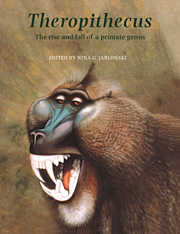Book contents
- Frontmatter
- Contents
- List of Contributors
- Preface
- Acknowledgements
- 1 Introduction
- PART I Fossil evidence and phylogeny
- PART II Biogeography and evolutionary biology
- PART III Anatomy of the fossil and living species of Theropithecus
- PART IV Behaviour and ecology of living and fossil species of Theropithecus
- 15 Social organization of the gelada
- 16 The ecology of Theropithecus gelada
- 17 Food digestion and energetic conditions in Theropithecus gelada
- 18 Socioecology of the extinct theropiths: a modelling approach
- 19 Ecological energetics and extinction of giant gelada baboons
- Appendix I A partial catalogue of fossil remains of Theropithecus
- Appendix II Conservation status of the gelada
- Index
19 - Ecological energetics and extinction of giant gelada baboons
Published online by Cambridge University Press: 11 November 2009
- Frontmatter
- Contents
- List of Contributors
- Preface
- Acknowledgements
- 1 Introduction
- PART I Fossil evidence and phylogeny
- PART II Biogeography and evolutionary biology
- PART III Anatomy of the fossil and living species of Theropithecus
- PART IV Behaviour and ecology of living and fossil species of Theropithecus
- 15 Social organization of the gelada
- 16 The ecology of Theropithecus gelada
- 17 Food digestion and energetic conditions in Theropithecus gelada
- 18 Socioecology of the extinct theropiths: a modelling approach
- 19 Ecological energetics and extinction of giant gelada baboons
- Appendix I A partial catalogue of fossil remains of Theropithecus
- Appendix II Conservation status of the gelada
- Index
Summary
Summary
Extinction is an evolutionary process well represented by the fossil record. The giant gelada, Theropithecus oswaldi, is taken as a case study of extinction.
Here we show that the effects of climatic change or competitive pressures, the usual proposed mechanisms of extinction, are mediated through behaviour.
The energetic requirements of T. oswaldi are modelled, along with correlated life history parameters. The extinction of the giant gelada is suggested to result from limited nutritional intake, leading to a reduced reproductive rate as a consequence of size-specific life history parameters.
We suggest that individuals are timelimited in terms of energy acquisition when exploiting low quality forage. Inability to meet energetic requirements reduced reproductive rates to the point where populations appeared to become vulnerable to minor, localized environmental perturbations, and hence to extinction within their typical habitats.
Introduction
During the Pliocene and Pleistocene the Theropithecus baboons were both far more abundant and considerably larger than their modern representatives (Jolly, 1972). These species became extinct during the Middle Pleistocene or early Late Pleistocene. Predation by early hominids has been implicated in their extinction (Isaac, 1977), along with a generally changing environment (see Leakey, chapter 3) or competitive pressures from other species (see Pickford, chapter 8). However, new insights from evolutionary ecology may throw light on specifically why large terrestrial primates were at risk during this period. The question addressed here is that of extinction: the constraints on animals that increase their vulnerability and the processes and timing of extinction events in the fossil record.
- Type
- Chapter
- Information
- TheropithecusThe Rise and Fall of a Primate Genus, pp. 487 - 498Publisher: Cambridge University PressPrint publication year: 1993
- 4
- Cited by

